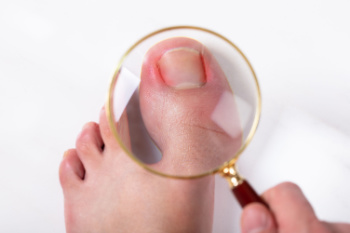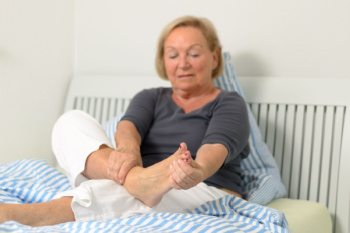Items filtered by date: January 2025
Symptoms and Causes of an Infected Ingrown Toenail

An ingrown toenail occurs when the edge of a toenail grows into the surrounding skin, often leading to pain and swelling. If left untreated, an ingrown toenail can become infected. Symptoms of an infected ingrown toenail include increased redness, warmth surrounding the affected area, and noticeable swelling. In more severe cases, pus or fluid may drain from the area, and the skin may become tender to the touch. The infection can cause throbbing pain, which may worsen with pressure from shoes or walking. Ingrown toenails are commonly caused by improper nail trimming, wearing tight footwear, or injury to the toe. They can also be influenced by genetics or certain foot conditions. If an ingrown toenail becomes infected, it is suggested that you promptly contact a podiatrist who can effectively treat this condition.
Ingrown toenails can become painful if they are not treated properly. For more information about ingrown toenails, contact Gregory Kranzusch, DPM of Foot and Ankle Center of St. Charles County. Our doctors can provide the care you need to keep you pain-free and on your feet.
Ingrown Toenails
Ingrown toenails occur when a toenail grows sideways into the bed of the nail, causing pain, swelling, and possibly infection.
Causes
- Bacterial infections
- Improper nail cutting such as cutting it too short or not straight across
- Trauma to the toe, such as stubbing, which causes the nail to grow back irregularly
- Ill-fitting shoes that bunch the toes too close together
- Genetic predisposition
Prevention
Because ingrown toenails are not something found outside of shoe-wearing cultures, going barefoot as often as possible will decrease the likeliness of developing ingrown toenails. Wearing proper fitting shoes and using proper cutting techniques will also help decrease your risk of developing ingrown toenails.
Treatment
Ingrown toenails are a very treatable foot condition. In minor cases, soaking the affected area in salt or antibacterial soaps will not only help with the ingrown nail itself, but also help prevent any infections from occurring. In more severe cases, surgery is an option. In either case, speaking to your podiatrist about this condition will help you get a better understanding of specific treatment options that are right for you.
If you have any questions please feel free to contact our office located in St. Charles, MO . We offer the newest diagnostic and treatment technologies for all your foot and ankle needs.
Understanding Gout in Women

Gout is often considered a condition that primarily affects men, but it can also impact women, particularly after menopause. This painful form of arthritis is caused by a buildup of uric acid in the body, leading to the formation of crystals in the joints. For women, hormonal changes, especially the decrease in estrogen after menopause, can increase the risk of gout. Other contributing factors include obesity, high blood pressure, and a diet rich in purine-heavy foods such as red meat, seafood, and alcohol. Symptoms of gout in women are similar to those in men and typically include sudden, intense pain, swelling, and redness in the affected joint, often starting in the big toe. Managing gout involves lifestyle changes such as maintaining a healthy weight, avoiding certain foods and drinks, staying hydrated, and taking medications as prescribed to reduce uric acid levels and prevent flare-ups. Gout can cause severe pain and foot discomfort. If you have symptoms of gout in your feet, it is suggested that you are under the care of a podiatrist who can accurately diagnose and treat this condition.
Gout is a foot condition that requires certain treatment and care. If you are seeking treatment, contact Gregory Kranzusch, DPM from Foot and Ankle Center of St. Charles County. Our doctors will treat your foot and ankle needs.
What Is Gout?
Gout is a type of arthritis caused by a buildup of uric acid in the bloodstream. It often develops in the foot, especially the big toe area, although it can manifest in other parts of the body as well. Gout can make walking and standing very painful and is especially common in diabetics and the obese.
People typically get gout because of a poor diet. Genetic predisposition is also a factor. The children of parents who have had gout frequently have a chance of developing it themselves.
Gout can easily be identified by redness and inflammation of the big toe and the surrounding areas of the foot. Other symptoms include extreme fatigue, joint pain, and running high fevers. Sometimes corticosteroid drugs can be prescribed to treat gout, but the best way to combat this disease is to get more exercise and eat a better diet.
If you have any questions please feel free to contact our office located in St. Charles, MO . We offer the newest diagnostic and treatment technologies for all your foot and ankle needs.
Causes and Symptoms of Ankle Sprains

An ankle sprain occurs when the ligaments, which are the sturdy bands of tissue connecting the bones in your ankle, are overstretched or torn. Ankle sprains often result from rolling your ankle inward or outward, stepping awkwardly on uneven ground, or twisting the joint. Common types of sprains are lateral sprains, which impact the outer ankle ligaments, medial sprains affecting the inner ligaments, and high ankle sprains involving the ligaments at the front of the ankle. Symptoms range from mild swelling and tenderness to severe pain, instability, and bruising that can limit walking. People with previous injuries, weak ankle muscles, or who wear inappropriate footwear are more susceptible to sprains. A podiatrist can perform a detailed examination, including imaging tests if needed, to identify the type and grade of the sprain. This foot doctor will provide expert care to reduce pain, restore mobility, and minimize the risk of recurring injuries. If you have sprained an ankle, it is suggested that you schedule an appointment with a podiatrist for a diagnosis and treatment options.
Ankle sprains are common but need immediate attention. If you need your feet checked, contact Gregory Kranzusch, DPM from Foot and Ankle Center of St. Charles County. Our doctors can provide the care you need to keep you pain-free and on your feet.
How Does an Ankle Sprain Occur?
Ankle sprains take place when the ligaments in your ankle are torn or stretched beyond their limits. There are multiple ways that the ankle can become injured, including twisting or rolling over onto your ankle, putting undue stress on it, or causing trauma to the ankle itself.
What Are the Symptoms?
- Mild to moderate bruising
- Limited mobility
- Swelling
- Discoloration of the skin (depending on severity)
Preventing a Sprain
- Wearing appropriate shoes for the occasion
- Stretching before exercises and sports
- Knowing your limits
Treatment of a Sprain
Treatment of a sprain depends on the severity. Many times, people are told to rest and remain off their feet completely, while others are given an air cast. If the sprain is very severe, surgery may be required.
If you have suffered an ankle sprain previously, you may want to consider additional support such as a brace and regular exercises to strengthen the ankle.
If you have any questions please feel free to contact our office located in St. Charles, MO . We offer the newest diagnostic and treatment technologies for all your foot and ankle needs.
